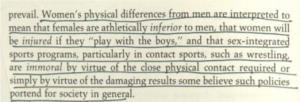The New Image of Female Athlete Bodies
During the early 1930s and 1940s, a woman being athletic and excelling in sports was deemed unseemly behavior for women, as reinforced by multiple claims and books. In 1934, Inez Haynes Irwin published Angels and Amazons. This book was his interpretation of the rise of women to public prominence, focusing on traditionally important fields like English and math. However, there was a noticeable and key absence of discussion on women in sports. In 1943, Amram Scheinfeld argued that “women were clearly inferior to men in all physical regards, such as strength and endurance… her muscular system has a more limited range for development” (Mrozek 283). Scheinfeld’s views were supported by comparing males and females to roosters and hens, claiming that “hens would be no match for roosters in some blood contests” (Mrozek 292). He also notes how female horses often scored fewer victories than male horses at the track.
 As noted in previous posts, J.A. Mangan’s and Roberta Park’s From Fair Sex to Feminism (seen to the left) highlights how the great female athletes of America always risked being considered a freak, or eccentric and a tomboy.
As noted in previous posts, J.A. Mangan’s and Roberta Park’s From Fair Sex to Feminism (seen to the left) highlights how the great female athletes of America always risked being considered a freak, or eccentric and a tomboy.
Janice Kaplan in Women and Sports notes how prior to the 1970s, women were holding themselves back just as much as societal pressures were. Kaplan notes how “what held women back… was their own image of themselves and the well-learned precept that they should always consider how their bodies looked rather than how they felt” (Kaplan, 17). Girls were used to thinking of their bodies as “someone else’s property” (Kaplan, 49). 
The quote to the right, from Kaplan’s book, highlights these differences.
How were women going to change their psyche around participating in sports and block out the stereotypes of society? It starts with women changing the way they saw their body. Jean Williams in A Contemporary History of Women’s Sport notes how during the 1970s and 1980s, an aerobics boom meant a growing body-consciousness where women cared about how they felt for themselves, not for men. The body was something to be worked on, and an increasing number of private gyms during this time helped accommodate women fitness to follow the famous female athletes (Williams, 254).
This charge was led by women athletes who wanted to break down male-only barriers in sports despite the anguish and humiliation they would face. Following Billie Jean King’s monumental win over Bobby Riggs in the “Battle of the Sexes” in 1973, the typical women stopped relating to “do-nothing beauties” and rather “[identified] with an energetic champion” (Kaplan, 18). In 1973, when virtually any male was deemed superior to any female at virtually anything, this event was symbolic. As McDonagh and Pappano note in Playing with the Boys, “The world saw a talented, muscular, and competent young woman close out distractions to win in tennis” (McDonagh and Pappano, 16). After Riggs had insisted that women belonged in the kitchen and the bedroom, and not the tennis court, the world took notice that female players were just as compelling as male players.
The new image of athletics had a great impact on the average women, and a boom of women finding ways to engage into physical activity began. And these women were proud of themselves. Kaplan recounts in an interview, with a woman who completed a marathon, how she was ecstatic how her “little body” ran 26.2 miles (Kaplan, 54. Women soon realized to love themselves and their athletic bodies, and this new image of a female athlete changed the way women sports forever.
Sources:
Kaplan, Janice. Women and Sports. Viking Press, 1979.
Mangan, J. A., and Roberta J. Park, editors. From ‘Fair Sex’ to Feminism: Sport and the Socialization of Women in the Industrial and Post-Industrial Eras. Routledge, 1987.
McDonagh, Eileen, and Laura Pappano. Playing with the Boys: Why Separate Is Not Equal in Sports. Oxford University Press, 2009.
Williams, Jean. A Contemporary History of Women’s Sport, Part One: Sporting Women, 1850-1960. Routledge, Taylor & Francis Group, 2016.
